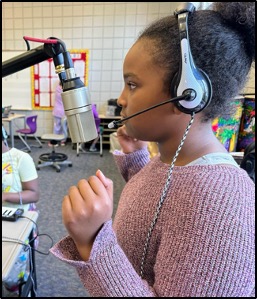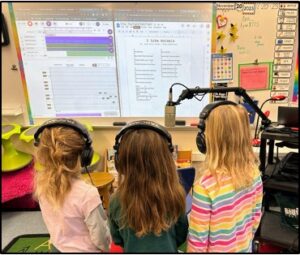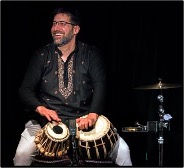Fostering the growth of the creative process in children is like growing a garden in the most fertile soil. With exposure to the right elements, and plenty of time and space to grow, we, as educators, can curate a creative culture that benefits students well beyond the classroom. In my 17th year as an elementary music teacher I can say that, hands down, placing the student in the center of the creative process is the most inspiring, exciting, and rewarding experience one can share with their students.
As we provide our students with the tools, time, and guidance to create not only are we providing them with a unique level of ownership in their work, we are also opening many new avenues for authentic assessment that go well beyond the usual identification-style tests.
Authentic assessments involve the application of knowledge and skills in real-world situations, scenarios, or problems. Authentic assessments create a student-centered learning experience by providing students opportunities to problem-solve, inquire, and create new knowledge and meaning.
Center for the Advancement of Teacher Excellence
University of Illinois, Chicago
I am a K-5 music educator coming to you from the front lines of the public education system. My personal mission in education centers around fostering the creative process by making original music with my students as often as possible. I discovered my passion for creating original music with my students 18 years ago in an upper elementary mixed classroom of grades 4,5, and 6, and it wasn’t even my idea!
 It was 2006, my first full year of teaching. A couple of upper elementary teachers had the idea that I could create an original piece of music with their students, burn it to a CD, and then auction the CD at the upcoming PTO fundraising auction. I was hesitant at first, but ultimately agreed. From the moment I introduced the idea to the students, they were interested, thoughtful, and highly engaged in the entire process. The song developed into a slow reflective, day-in-the-life ballad. Once the song was written and rehearsed, I brought in a laptop computer, a small Digital Audio Interface (DAI), and one SM57 microphone. We spent a full 45 minutes trying to get one good take. I had the CD in hand the next day and my original song project was done,or so I thought…
It was 2006, my first full year of teaching. A couple of upper elementary teachers had the idea that I could create an original piece of music with their students, burn it to a CD, and then auction the CD at the upcoming PTO fundraising auction. I was hesitant at first, but ultimately agreed. From the moment I introduced the idea to the students, they were interested, thoughtful, and highly engaged in the entire process. The song developed into a slow reflective, day-in-the-life ballad. Once the song was written and rehearsed, I brought in a laptop computer, a small Digital Audio Interface (DAI), and one SM57 microphone. We spent a full 45 minutes trying to get one good take. I had the CD in hand the next day and my original song project was done,or so I thought…
The very next class, the students wanted to know what the next song would be. They wondered about releasing a whole album. One student brought in a song he wrote at home about traveling all over the USA. When Martin Luther King Day came around, the students wanted to make their own music to perform at the school assembly. From that very first song, my mission became clear. Give the students the opportunity to create as often as possible. Since then I have produced over 200 songs with elementary students, and with the advent of platforms like Soundtrap, I have watched students create thousands of pieces of music on their own.
The benefits of this work go well beyond the actual music that is created. Over the years I have discovered that when you create a piece of music with a class, and then give them the opportunity to perform it in public, their engagement in the creative process is greatly heightened. Students take ownership of their learning, of the music they create. They are now sharing a piece of themselves. Our elementary school music concerts became “World Premiere Performances” and “Album Release Events.” We upload the music online so they can share it with friends and relatives all over the world. The music created is a source of pride and reflection. Here is an example from the students at King Elementary.
With heightened engagement comes an opportunity to create new roles and responsibilities in the classroom. If, for example, a student helps to adjust a mic, or press record before a take, we refer to them as “Audio Engineers.” Perhaps some students are  keen on creating artwork to represent the musical piece, or making a poster to advertise the concert, they become the “Album Artists.” Our concerts have Production Managers, Backstage Managers, Lighting Tech’s, and so on. I strive to create new roles in the music classroom that reflect real-world roles in the music business. All of this engagement begins by fostering the creative impulse within each student. Simply showing them that their ideas matter and that they are capable of doing it, puts them on a path of seeking out ownership and engagement in the learning.
keen on creating artwork to represent the musical piece, or making a poster to advertise the concert, they become the “Album Artists.” Our concerts have Production Managers, Backstage Managers, Lighting Tech’s, and so on. I strive to create new roles in the music classroom that reflect real-world roles in the music business. All of this engagement begins by fostering the creative impulse within each student. Simply showing them that their ideas matter and that they are capable of doing it, puts them on a path of seeking out ownership and engagement in the learning.
Developing a creative culture in any school takes time and dedication. We are all learning as we go. Along the way, we, as teachers, also need to develop unique and authentic ways of assessing the creative process. Self-reflection, peer reviews, informal observations, and performances of original work all empower you and your students to identify strengths and areas for growth. Just as each musical creation is unique, so is your process of authentic assessment. Here are some ideas for developing authentic assessment around original music creation.
- Production: Managing recording equipment, designing album artwork, and creating promotional materials become avenues for assessing practical skills and problem-solving abilities.
- Public performances: Audience surveys and interviews reveal the impact of the music and performance skills, thus offering valuable feedback for self-reflection and improvement.
- Sharing music online: Downloads, comments, and other engagement metrics become indicators of reaching and connecting with a wider audience, fostering a sense of global community.
- Designing assessment criteria: Involving students in crafting rubrics and success markers fosters self-awareness, ownership, and a deeper understanding of learning goals.
- Choice and differentiation: Allowing students to choose roles, instruments, and creative approaches personalizes the learning experience and caters to individual interests and strengths.
- Celebrating progress: Recognizing individual and collective achievements throughout the process reinforces a growth mindset and fuels continuous learning.
As I witness my students blossom into confident creators, I’m reminded that music isn’t just about notes on a page, it’s a language that speaks to the soul. Through the power of authentic assessment, we can unlock student potential, nurturing not only musical skills, but also the invaluable 21st-century skills needed to thrive in an ever-changing world. The beauty of original music creation lies not just in the final product, but in the journey itself. By centering the creative process and embracing authentic assessment, we equip our students with effective tools to navigate that journey – to experiment, to collaborate, to learn from their experiences, and ultimately, to discover their own unique voices. And that, my friends, is a symphony worth celebrating.
________________________________________________________________________________________________________________
Editor’s Note: To learn more about authentic assessment check out the Michigan Assessment Consortium’s recent seminar presented by Bryan Goodwin. For more specific moments, check out these learning points:
- How authentic assessments deepen learning.
- Why the traditional teach-study-test model persists in classrooms.
- Steps that help teachers use authentic assessments that require students to extend and apply learning.
- How teachers can become more intentional in teaching and assessment methods.
 In addition to John Churchville’s 17 years in K-12 music classrooms, he is a Grammy award winning tabla player living in Ann Arbor and teaching at Pattengill Elementary. John got his start in music in Marquette then moved west to attend the esteemed California Institute of the Arts where he earned a degree in World Music Performance. He has since earned his Master’s in Music Education from the University of Michigan. John developed a nationally recognized and award winning elementary music program with a focus on student ownership, creativity, and technology integration. John serves as the MACC Regional Lead for Region 9 of the Michigan Regional Arts Education Networks coordinated by MAEIA, the Michigan Arts and Culture Council, and local arts educators and ambassadors. John has forged a unique path in both the music scene and in music education.
In addition to John Churchville’s 17 years in K-12 music classrooms, he is a Grammy award winning tabla player living in Ann Arbor and teaching at Pattengill Elementary. John got his start in music in Marquette then moved west to attend the esteemed California Institute of the Arts where he earned a degree in World Music Performance. He has since earned his Master’s in Music Education from the University of Michigan. John developed a nationally recognized and award winning elementary music program with a focus on student ownership, creativity, and technology integration. John serves as the MACC Regional Lead for Region 9 of the Michigan Regional Arts Education Networks coordinated by MAEIA, the Michigan Arts and Culture Council, and local arts educators and ambassadors. John has forged a unique path in both the music scene and in music education.
Images from Pattengill Elementary and King Elementary provided by the author.
Click here for a Printer friendly version of this article.
Leave a Reply
You must be logged in to post a comment. Don't have an account? Register Here.